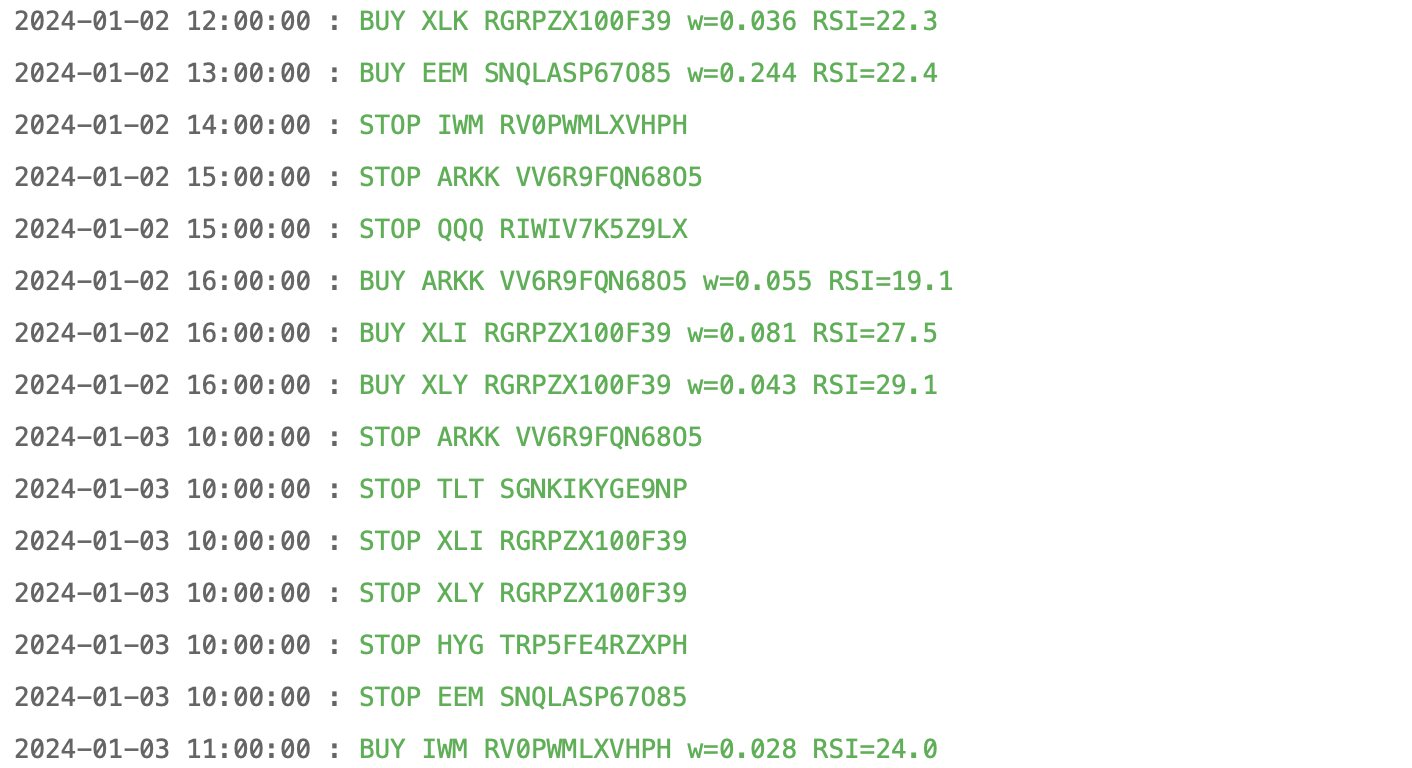Daily ETF RSI-MA Bot on Quantconnect
Hourly swing-trader with momentum fallback
Scans the 20 most-liquid US ETFs each hour, buys when RSI rebounds from oversold and the 50-hour MA sits above the 200-hour MA. If nothing is oversold, it falls back to a simple 30-day momentum rank so it never stands idle. Risk is allocated by inverse ATR and capped at 2 × gross exposure.

Core Parameters
# look-back & thresholds rsiPeriod = 14 fastPeriod, slowPeriod = 50, 200 # hourly SMA trend filter oversold, overbought = 30, 70 # risk & exits stopATR = 1.5 # initial stop trailATR = 1.5 # trailing once in profit holdMaxHrs, earlyExitHrs = 48, 32 earlyExitATR = 0.5 # bail if no progress targetExposure = 2.0 # 2× gross cap
These numbers aim for frequent trades but shallow risk— a 1½ × ATR stop is tight on purpose to keep max drawdown low.
Universe → keep it liquid
def CoarseSelection(self, coarse):
liquid = [c for c in coarse
if c.Symbol.Value in self.etfCandidates
and c.DollarVolume > 25e6] # ≥ $25 M / day
return [c.Symbol for c in sorted(liquid,
key=lambda x: x.DollarVolume,
reverse=True)[:30]]Anything thinner than $25 M daily volume is skipped to avoid sloppy spreads and halts.
Risk-On Regime Check
self.spyFast = self.SMA('SPY', 50, Resolution.Hour)
self.spySlow = self.SMA('SPY', 200, Resolution.Hour)
riskOn = self.spyFast.Current.Value > self.spySlow.Current.ValueThe bot only opens new trades when SPY’s short MA is above its long MA—keeps it out of bear swoons.
Entry: RSI swing-reversal
longSetup = (rsi < 30) and (rsi > prevRsi) # ticking up
trendUp = sma50 > sma200
if riskOn and longSetup and trendUp:
self.SetHoldings(sym, +weight)- Mirror logic for shorts when
RSI > 70plus down-trend. - If no ETF is oversold/overbought, the bot looks at price momentum over the past 30×7 bars:
hist = self.History(sym, 210, Resolution.Hour) momentum = (price - hist.close.iloc[0]) / hist.close.iloc[0]
Sizing: inverse-ATR
invVol[sym] = 1 / atrValue w = invVol[sym] / Σ(invVol) * targetExposure # <= 2× gross
Quiet ETFs (low ATR) get bigger weights; choppy ones get trimmed so each position risks roughly the same euro amount.
Exit rules
stop = entry - 1.5 * ATR
trail = price - 1.5 * ATR # only ratchets higher
if heldHrs >= 32 and price < entry + 0.5 * ATR:
self.Liquidate(sym) # early exit (no progress)
if heldHrs >= 48:
self.Liquidate(sym) # hard time-stopStops trail by the same ATR multiple to keep risk constant as a trade moves.
How one hour flows

Every hour: update indicators → score momentum → size positions → log to QC.
Back-test detail
- Win rate: 47 %
- Profit-loss ratio: 1.32
- Expectancy: 0.10 R per trade
- Turnover: ≈ 40 % of the book per year
- Fees: $0 (Alpaca sim)

Stats exported from QuantConnect run “Well Dressed Sky Blue Tapir”
Next → Iteration ideas
- Pause short-selling when VIX < 15 (fade traps).
- Add a
> 2 × ATRgap filter to skip blow-outs at the open. - Rolling 20-day Sharpe guardrail → auto-suspend on 3 σ slumps.
- Stream logs to FastAPI for near-real-time PnL dashboards.
Building this bot was genuinely fun—every tweak taught me something new about Lean and market micro-behaviour. I’m definitely going to sink more evenings into refining these edges! :)